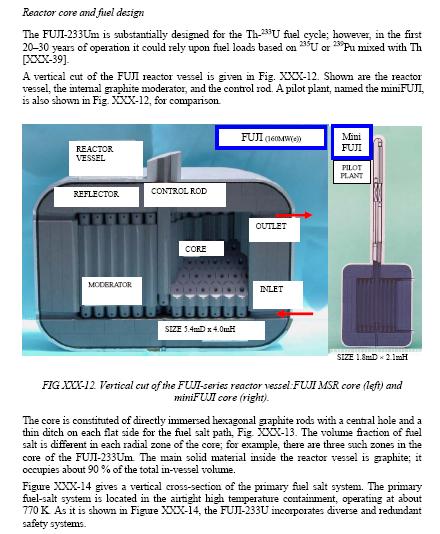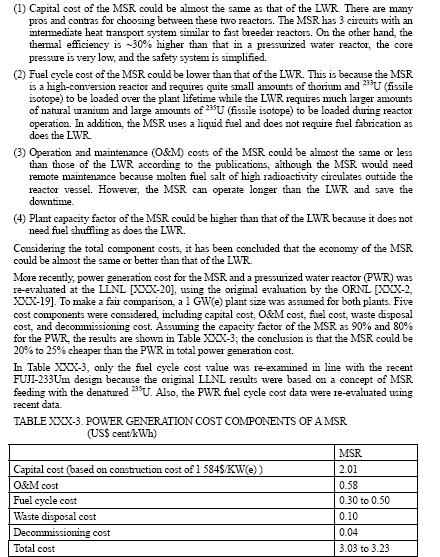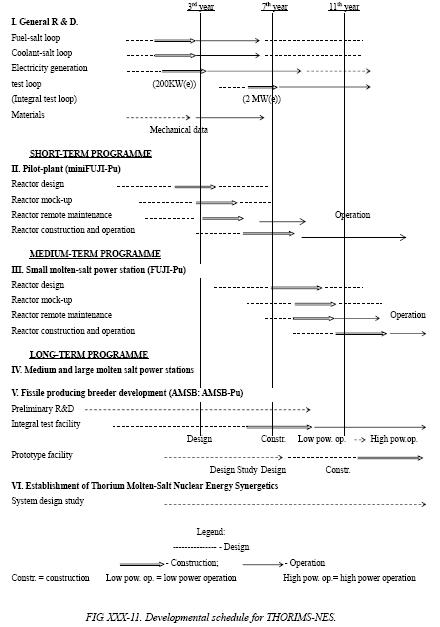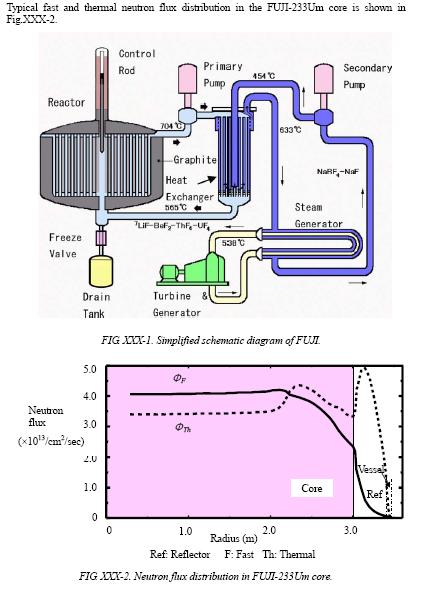The Fuji Molten salt reactor is a japanese design that can run on thorium or a mix of thorium and Uranium or Plutonium. The project plan is to take 8 or 9 years to develop a miniFuji reactor and 12-15 years to develop a Fuji reactor. The R & D is mostly related to the details of the structural material and components.
-How to exactly modify the Hastelloy N alloy (increasing Cr and reducing Co)
-analyse and test low tensile strength parts like the tubing elbow
The projected costs for the reactor are about 20-25% less than a PWR and a little less than a LWR.
The Encyclopedia of Earth claims that the 100 MWe FUJI MSR design is being developed internationally by a Japanese, Russian and US consortium.
The attractive features of this MSR fuel cycle include: the high-level waste comprising fission products only, hence shorter-lived radioactivity; small inventory of weapons-fissile material (plutonium-242 being the dominant plutonium isotope); low fuel use (the French self-breeding variant claims 50kg of thorium and 50kg uranium-238 per billion kWh); and safety due to passive cooling up to any size.
Currently nuclear reactors use about 100 to 200 tons of uranium every year. 10,000 to 20,000 kg of uranium per billion kWh. 200 to 400 times more uranium than the french msr design uses. The MSR can generate 1000 times less uranium and plutonium waste and everything else that is left over has a halflife of less than 50 years.
Several of the Fuji designs fit the IAEA definition of a small reactor that generates less than 300Mwe. There is interest in small reactors due partly to the high capital cost of large nuclear power reactors generating electricity via the steam cycle and partly to consideration of public perception, there is a move to develop smaller units. These may be built independently or as modules in a larger complex, with capacity added incrementally as required. Economies of scale are provided by the numbers produced. There are also moves to develop small units for remote sites.
The most prominent modular project is the South African-led consortium developing the Pebble Bed Modular Reactor (PBMR) of 170 MWe. In China, Chinergy is preparing to build a similar unit, the 195 MWe HTR-PM. A US-led group is developing another design with 285 MWe modules.
Each PBMR unit will finally discharge about 19 tonnes/yr of spent pebbles to ventilated on-site storage bins. Eventual construction cost (when in clusters of four or eight units) is expected to be very competitive, and generating cost is projected below US3 cents/kWh. Each 210g fuel pebble contains about 9g uranium and the total uranium in one fuel load is 4.1 t. MOX and thorium fuels are envisaged. With used fuel, the pebbles can be crushed and the 4% of their volume which is microspheres removed, allowing the graphite to be recycled. The company says microbial removal of carbon-14 is possible (also in the graphite reflectors when decommissioning). So ideally PBMR should generate about 1000kg/year (1 ton/yr) of waste or 30,000 kg over 30 years of operation. This is 15 times more waste than the Fuji MSR and it would have long lived radiative material.
Generally, modern small reactors for power generation are expected to have greater simplicity of design, economy of mass production, and reduced siting costs. Many are also designed for a high level of passive or inherent safety in the event of malfunction. Traditional reactor safety systems are ‘active’ in the sense that they involve electrical or mechanical operation on command.
Small-medium reactors with development claimed to be well advanced
NAME Power Type Who is Developing
CAREM 27 MWe PWR CNEA & INVAP, Argentina
KLT-40 35 MWe PWR OKBM, Russia
MRX 30-100 MWe PWR JAERI, Japan
IRIS-50 50 MWe PWR Westinghouse, USA
SMART 100 MWe PWR KAERI, S. Korea
NP-300 100-300 MWe PWR Technicatome (Areva), France
Modular SBWR 50 MWe BWR GE & Purdue University, USA
PBMR 165 MWe HTGR Eskom, South Africa, et al
GT-MHR 285 MWe HTGR General Atomics (USA), Minatom (Russia) et al
BREST 300 MWe LMR RDIPE (Russia)
FUJI 100 MWe MSR ITHMSO, Japan-Russia-USA
South Korea’s SMART (System-integrated Modular Advanced Reactor) is a 330 MWt pressurized water reactor with integral steam generators and advanced safety features. It is designed for generating electricity (up to 100 MWe) and/or thermal applications such as seawater desalination. The design life is 60 years, with a 3-year refuelling cycle. A one-fifth scale plant (65 MWt) is being constructed and expected to begin operation in 2007.

Fuji Molten Salt Reactor vessel and the mini-Fuji Molten salt reactor

Here is the schematic of the larger reactor plant
FURTHER DETAILS:
Most of the information for this article is from the 870 page status report on small reactors pages 821-870 and the rest from the already cited Encyclopedia of Earth.

Accumulated waste over 30 years is about 880kg in the salt and 750kg in the gas. This is very little waste and they are not long life radioactive material

The projected costs for the reactor are about 20-25% less than a PWR and a little less than a LWR.

The proposed project development schedule.

The neutron flux distribution

Brian Wang is a Futurist Thought Leader and a popular Science blogger with 1 million readers per month. His blog Nextbigfuture.com is ranked #1 Science News Blog. It covers many disruptive technology and trends including Space, Robotics, Artificial Intelligence, Medicine, Anti-aging Biotechnology, and Nanotechnology.
Known for identifying cutting edge technologies, he is currently a Co-Founder of a startup and fundraiser for high potential early-stage companies. He is the Head of Research for Allocations for deep technology investments and an Angel Investor at Space Angels.
A frequent speaker at corporations, he has been a TEDx speaker, a Singularity University speaker and guest at numerous interviews for radio and podcasts. He is open to public speaking and advising engagements.

